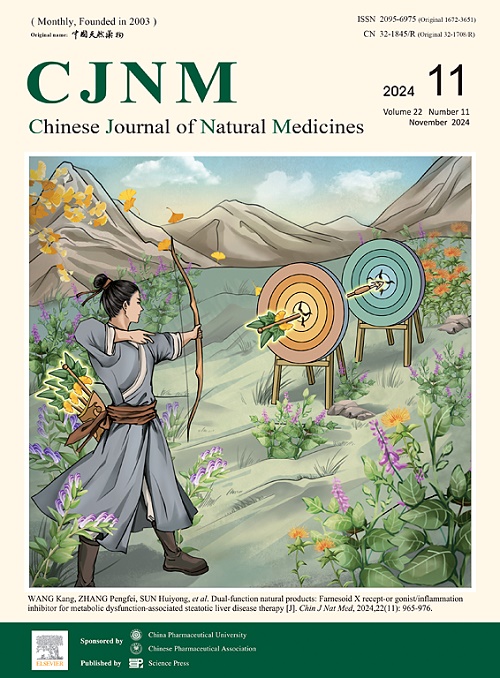中国海兔中具有重要生物和生态价值的天然产物:结构、立体化学及其他成分
IF 4
2区 医学
Q1 INTEGRATIVE & COMPLEMENTARY MEDICINE
引用次数: 0
摘要
从很少被研究的海兔 Bursatella leachi 身上分离出了一种新的酰胺类生物碱 Bursatamide A (1),该生物碱具有前所未有的丙基六氢萘碳框架,同时分离出的还有一种新的 3-苯氧基丙腈生物碱 Bursatellin B (2) 和 12 种已知化合物。通过全面的光谱数据分析阐明了 1 和 2 的结构,同时通过全合成和一系列量子化学计算(包括计算电子圆二色性光谱、光学旋转色散(ORD)方法和 DP4+ 概率分析)确定了它们的相对和绝对构型(AC)。熊果酰胺 A (1) 对人类致病细菌李斯特菌和霍乱弧菌具有抑制作用。2 的非对映异构体赤藓囊素 B(21)对鱼类致病菌副猪链球菌 FP KSP28 具有显著的抗菌活性,其 MIC90 值为 0.0472 μg-mL-1。本文章由计算机程序翻译,如有差异,请以英文原文为准。
The biologically and ecologically important natural products from the Chinese sea hare Bursatella leachii: structures, stereochemistry and beyond
A novel amide alkaloid, bursatamide A (1), featuring an unprecedented propyl-hexahydronaphthalene carbon framework, was isolated from the infrequently studied sea hare Bursatella leachi, alongside a new 3-phenoxypropanenitrile alkaloid, bursatellin B (2), and twelve known compounds. The structures of 1 and 2 were elucidated through comprehensive spectroscopic data analyses, while their relative and absolute configurations (ACs) were established through total synthesis and a series of quantum chemical calculations, including calculated electronic circular dichroism (ECD) spectra, optical rotatory dispersion (ORD) methods, and DP4+ probability analyses. Bursatamide A (1) demonstrated inhibitory effects against the human pathogenic bacteria Listeria monocytogenes and Vibrio cholerae. Erythro-bursatellin B (21), a diastereoisomer of 2, exhibited notable antibacterial activity against the fish pathogenic bacterium Streptococcus parauberis FP KSP28, with an MIC90 value of 0.0472 μg·mL−1.
求助全文
通过发布文献求助,成功后即可免费获取论文全文。
去求助
来源期刊

Chinese Journal of Natural Medicines
INTEGRATIVE & COMPLEMENTARY MEDICINE-PHARMACOLOGY & PHARMACY
CiteScore
7.50
自引率
4.30%
发文量
2235
期刊介绍:
The Chinese Journal of Natural Medicines (CJNM), founded and sponsored in May 2003 by China Pharmaceutical University and the Chinese Pharmaceutical Association, is devoted to communication among pharmaceutical and medical scientists interested in the advancement of Traditional Chinese Medicines (TCM). CJNM publishes articles relating to a broad spectrum of bioactive natural products, leading compounds and medicines derived from Traditional Chinese Medicines (TCM).
Topics covered by the journal are: Resources of Traditional Chinese Medicines; Interaction and complexity of prescription; Natural Products Chemistry (including structure modification, semi-and total synthesis, bio-transformation); Pharmacology of natural products and prescription (including pharmacokinetics and toxicology); Pharmaceutics and Analytical Methods of natural products.
 求助内容:
求助内容: 应助结果提醒方式:
应助结果提醒方式:


